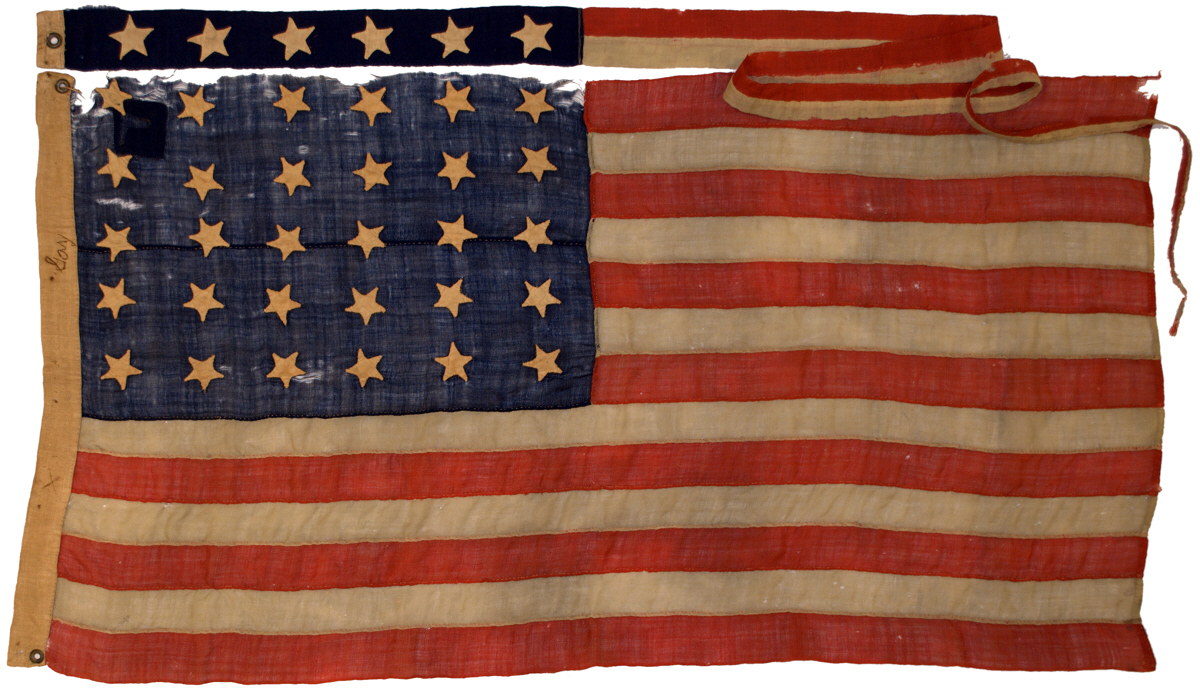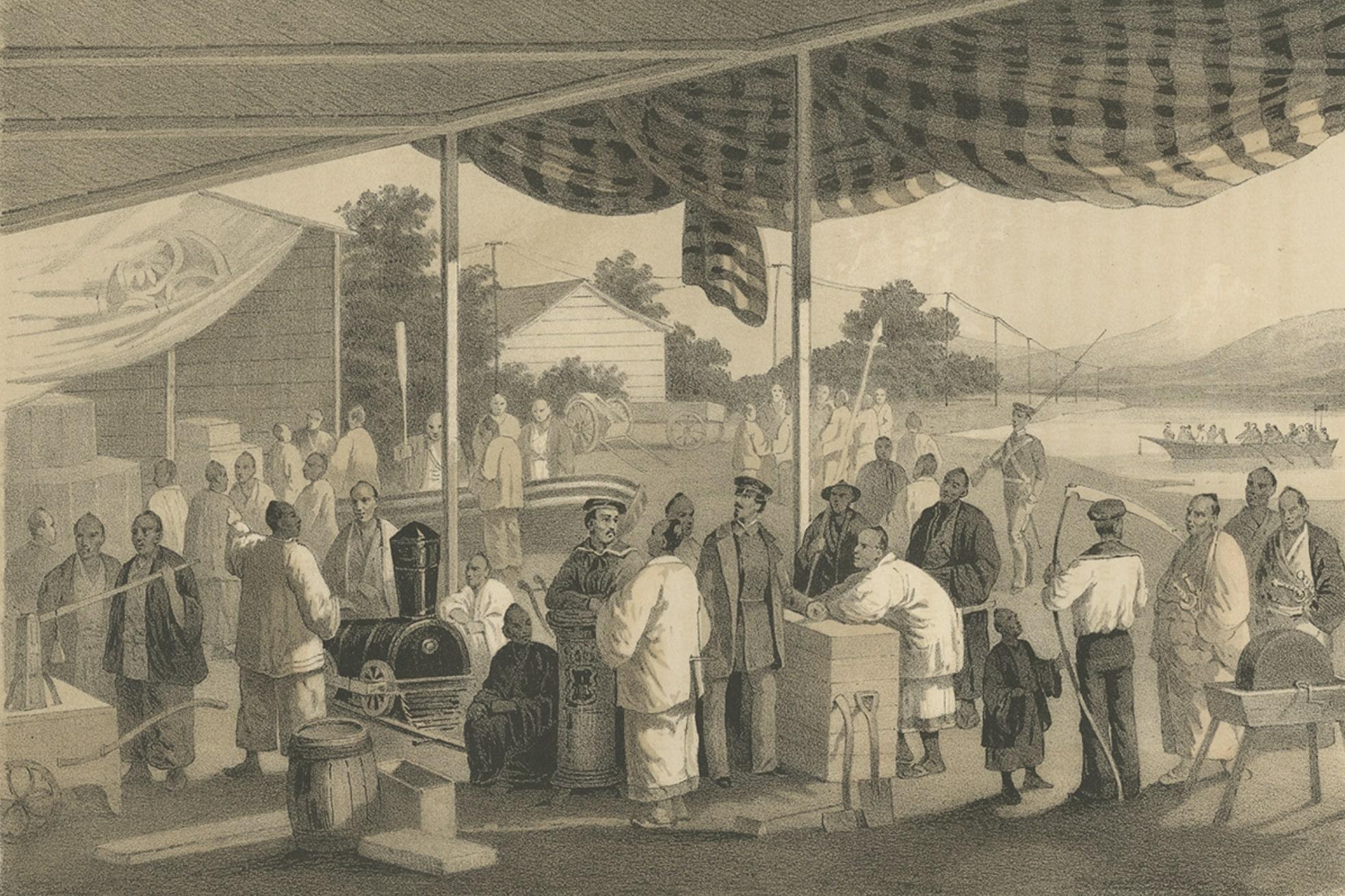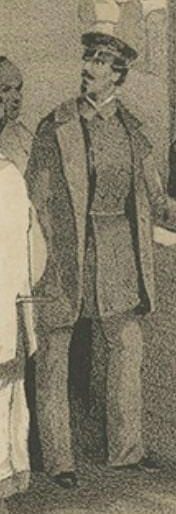
The story of this flag
is a fascinating example of how family lore, though not
always precisely accurate, often has roots in actual
history; and that the actual history is often times just
as exciting as that in family lore. The flag was
acquired with solid documentation from one of the last
surviving family members of its original owner, Chief
Engineer Jesse Gay, U.S. Navy. The written history
accompanying the flag claims that it was the battle flag
of the USS Kearsarge, one of the Civil War's most
storied battleships, and that Jesse Gay served as the
ship's captain.
Investigation into the flag reveals that although the
flag is not tied to the USS Kearsarge, it is
actually an extremely rare battle flag from the USS
Mississippi. The Mississippi was one of the most
famous battleships of the Mexican War. She served as the
flagship of Commodore Matthew Perry both during the
Mexican War (1846-1848) and his famous expedition to Japan (1852-1855), and Chief Engineer Gay served
as Commodore Perry's chief engineer on the USS
Mississippi during these historic times. The two
men spent years at sea together, with Gay responsible
for the overall maintenance and performance of Perry's
beloved flagship. Gay served on the USS Mississippi for
most of his career, from at least 1846 to the end of the
Japan expedition in 1855, and this commissioning pennant
and flag would have been flown from 1848-1850 during his
time aboard the ship. The
history of this flag, the USS Mississippi, Commodore Perry, and Chief
Engineer Gay are marvelously intertwined and captured in
the timeline below.
|
|
1839 |
|
Commodore Matthew Perry personally
supervises the construction of the USS
Mississippi, a side-paddle steamer that
would later become his flagship. |
|
|
|
1841 |
|
The USS Mississippi is commissioned. |
|
|
|
1845 |
|
The USS Mississippi joins the West Indian
Squadron and serves as Commodore Perry's
flagship during operations to stem piracy in
the Caribbean and Gulf of Mexico. |
|
|
|
1846 |
|
The outbreak of the Mexican War sees the USS
Mississippi participating in a series of
expeditions against Mexico. |
|
|
|
1847 |
January 1 |
The USS Mississippi returns to port in
Virginia for repairs. |
|
| |
February 20 |
Engineer Jesse Gay of the USS Mississippi is
promoted to First Assistant Engineer. |
|
| |
March 9-29 |
The USS Mississippi participates in the
Siege of Veracruz. |
|
| |
June 16 |
The USS Mississippi participates in the
Second Battle of Tabasco and Commodore Perry
captures Villanermosa |
|
|
|
October 13 |
The Aztec Club
of 1847, which becomes the Military Society
of Mexican War Veterans, is established in
Mexico City. Matthew Perry, Zachary
Taylor, Winfield Scott, George McClellan,
Ulysses S. Grant, Robert E. Lee, James
Longstreet, P.T. Beauregard and Franklin
Pierce are among its notable members. |
|
|
|
1848 |
February 2 |
The Mexican War ends. Commodore Perry
returns to shore duty, while Jesse Gay
remains on duty with the USS Mississippi. |
|
| |
May 29 |
The 30 star
flag becomes official with the
entry of Wisconsin. We have 30 States
for a period of 2 years and 103 days, and 30
Stars is the official star count from July
4, 1848 to July 4, 1851. The 30 star
flag in the Rare Flags Collection would have
been flown on the ship at this time. |
 |
| |
October 31 |
First
Assistant
Engineer Jesse Gay is promoted to Chief
Engineer. |
|
1849 |
|
The USS Mississippi cruises the
Mediterranean Sea under the 30 star flag. |
|
|
1850 |
September 9 |
The 31 star
flag becomes official with the entry of
California. The new 31 star flag
replaces our 30 star flag, and it is
possible that Jesse Gay, who had been
serving on the ship through distinguished
service in the Mexican War and Mediterranean
Sea deployments, received the 30 star flag
and 6 Star Commissioning Pennant as a
memento at this time. It's also
possible that the flag was simply retired,
and later given to Jesse Gay by Commodore
Perry himself at the end of the Japan
voyage. The closeness of their
relationship is apparent in later fraternal
associations between the two men in later
years. They served at sea and in combat
together for many years, and Gay was
responsible for the mechanical functioning
of the flagship whose construction Perry
personally supervised. In either case,
whether in Jesse Gay's personal possession during the
Japan voyage or gifted to him after, the
flag would have remained on the
ship in its flag locker as a secondary or spare flag
during the upcoming Voyage to Japan.
The USS Mississippi's 31 star flag flown by
Perry during the Voyage to Japan, which
replaces our flag, is one of the most famous
American Flags in existence. Now in
the collection of the US Naval Academy at
Annapolis,
Commodore Perry's 31 Star Flag
was present during the Japanese surrender to
General Douglas MacArthur aboard the USS
Missouri on September 2, 1945. |
|
|
|
1851 |
November 8 |
Chief Engineer
Jesse Gay writes an important letter,
written at sea from the USS Mississippi,
detailing technical efficiencies in design
that can be learned from the USS Mississippi
to improve future ships. |
|
|
|
1852 |
November 24 |
Commodore
Perry returns from shore duty to prepare for
his voyage to Japan. The USS Mississippi
clears Hampton Roads, Virginia and once
again serves as Commodore Perry's flagship.
Prior to departing Chief Engineer Gay writes
to Norris Brothers of Philadelphia, asking
for a reduced scale model of a locomotive
and cars as one of the gifts to for the
Emperor of Japan.1
During the
Japanese Voyage, both this 30 star and the
famous 31 star flag, along with other
ensigns from the flag locker of the USS
Mississippi, would have been flown as part
of the customary practice of festooning a
ship with all of its colors during its
arrival in foreign ports. |
|
|
|
1853 |
May 4 |
The USS
Mississippi reaches Shanghai, China |
|
|
|
July 8 |
The USS
Mississippi reaches Tokyo Bay, Japan |
|
|
|
1854 |
March 30 |
Chief Engineer
Jesse Gay is mentioned in Wilhelm Heine's
memoirs of the Japan voyage,
With Perry to
Japan: A Memoir.
"Meanwhile our engineers [Chief
Engineer Jesse Gay in charge,
aided by his first assistant,
Robert Danby, both of the
Mississippi] and mechanics
worked and worked to unpack and
assemble our gifts to the
emperor. The astonishment of the
Japanese increased with the
opening of each crate. Indeed,
these American gifts to Japan
were so beautiful they would
have caused amazement and
produced applause in any country
in the world.
The Japanese marveled most at
the railroad. Locomotive,
tender, and passenger cars
(built by Norris [Brothers,
locomotive works] in
Philadelphia, all of course at
reduced scale), paneling in two
varieties of rosewood, metalwork
of superior craftsmanship —
these features amounted to the
most attractive example [of a
railroad] that I had ever seen.
The rails were laid in a circle
about a mile in circumference."2
|
|
|
|
1855 |
April 23 |
The USS
Mississippi returns to New York City |
|
|
|
|
At a meeting
at Delmonico's Restaurant in New York City,
officers of the Mexican War form The
Montezuma Society to renew ties between
Mexican War veterans, advancing the idea of
the original Aztec Club which was failing to
meet the needs of its members due to a weak
constitution. The elected officers of
the The Montezuma Society include Commodore
Matthew Perry as President, and Chief
Engineer Jesse Gay as Treasurer.3 |
|
|
|
1856 |
December 9 |
Chief
Engineery Jesse Gay descends in the Nautilus
Submarine Company's Nautilus Submarine in
New York Harbor, and reports on the
experience to Captain A. Bigelow, Commander
of the New York Navy Yard.4 |
|
|
|
1858 |
March 4 |
Commodore
Perry dies. |
|
|
|
1859 |
October 22 |
Chief Engineer
Jesse Gay resigns. Later indications
are that it is under duress for his
political sympathies in favor of the Union. |
|
|
|
1861 |
March 8 |
A New York
Times article regarding President Lincoln's
decision to appoint a new Chief Engineer of
the Navy mentions Jesse Gay as a potential
appointee.
"The
pressure for the removal of Mr. ARCHBOLD,
Engineer-in-Chief of the Navy, will soon be
made. Among the parties who will be urged
for the place is JESSE GAY, who was formerly
senior engineer, and it is said was
persecuted by Secretary TOUCEY on account of
his political sympathies, until he was
compelled to resign. It is stated that he
was even ordered to a first assistant's
position, as engineer of a gun-boat, while
the sloop-of-war Hartford, after he had
superintended the construction and setting
up of her machinery, was sent to sea with a
junior engineer in charge."
5
A New York
Times article of October 9, 1864, mentions a
test sail of the Fusiyama, a steam corvette
built in New York City under contract for
the Imperial Navy of Japan. The engines of
the ship were built under the supervision of
"the late Chief Engineer Jesse Gay, of the
United States Navy". Another article
from the New York Times, dated September 5,
1865, describes the delivery of the Fusiyama.
"The engines, which are a beautiful specimen
of workmanship, were built by JAMES MURPHY &
CO, under the superintendence of JESSE GAY,
late Chief Engineer of the United States
Navy, but now Superintending Engineer of the
Imperial Navy of Japan."6 |
|
|
Both the flag and the
pennant are made of hand sewn wool bunting with cotton
stars. The presence of six stars on a Navy
Commissioning Pennant is very rare, but not unheard of.
It's apparent from the size of the flag, which also has
5 rows of 6 stars each, and their common history, that
the flag and pennant are intended to be flown together.
The grommets of the flag and pennant are very similar,
although the blue wool of the commissioning pennant is
much more dense than the canton of the flag. A
reason could be that the commissioning pennant, which is
thinner and lighter than the flag, would be more
susceptible to complete tears under heavy winds.
The use of metal grommets on a flag of this age is also
very rare. An early patent for a metal grommet
dates to 1848 (Patent #5779 to E. H. Penfield).
The use of metal grommets on this flag and pennant are
the earliest usage that I've encountered. Period
30 Star flags made of pieced-and-sewn construction are
also extremely rare in and of themselves, and I know of
just five or six other examples in existence. The
flag and pennant are an extraordinary witnesses to
American naval history and are remarkable survivors from
the pre-Civil War period.

 The
remarkable engraving above, titled Delivering of the American Presents
at Yokohama, originates from
'Narrative of the expedition of an American squadron to
the China seas and Japan, performed in the years 1852,
1853, and 1854, under the command of Commodore M.C.
Perry (..)' by Francis L. Hawks, published in 1856. It depicts the
scene of the unpacking of the locomotive and other gifts by Chief Jesse
Gay and his assistants. The engraving is based off of
drawings and water colors done by William Heine, who was
the official artist on Commodore Matthew C. Perry's
expedition to Japan in 1853-54 and witnessed and drew
the events first hand. In all likelihood, the senior
Navy man in the center of the image, clearly in charge
and his hand resting on one of the crates, is Chief
Jesse Gay himself. The
remarkable engraving above, titled Delivering of the American Presents
at Yokohama, originates from
'Narrative of the expedition of an American squadron to
the China seas and Japan, performed in the years 1852,
1853, and 1854, under the command of Commodore M.C.
Perry (..)' by Francis L. Hawks, published in 1856. It depicts the
scene of the unpacking of the locomotive and other gifts by Chief Jesse
Gay and his assistants. The engraving is based off of
drawings and water colors done by William Heine, who was
the official artist on Commodore Matthew C. Perry's
expedition to Japan in 1853-54 and witnessed and drew
the events first hand. In all likelihood, the senior
Navy man in the center of the image, clearly in charge
and his hand resting on one of the crates, is Chief
Jesse Gay himself.
1 The Growth of Technical Cooperation with
Governments Abroad, 1849-1853, Richard O. Cummings, The
Pacific Historical Review, Vol. 18, No. 2 (May, 1949),
pp. 199-212
2 Wilhelm
Heine, With Perry to Japan: A Memoir
3 Aztec Club Website,
History of its Founding Webpage
4
Knickerbocker, or New York Monthly Magazine, Vol.
49, pp. 209-210
5 New York Times,
March 8, 1861
6 New York Times,
September 5, 1865 |

